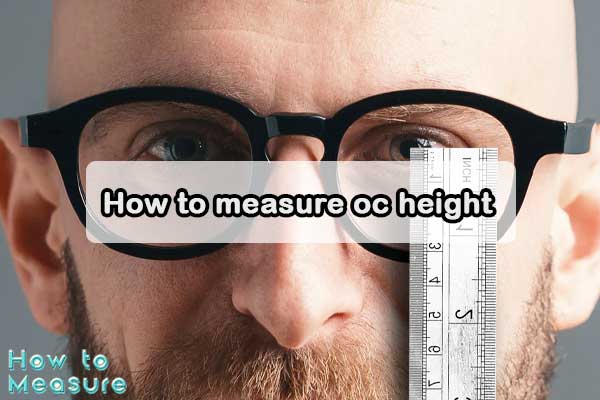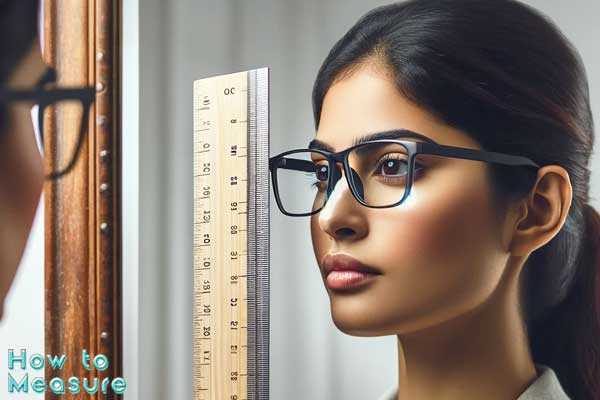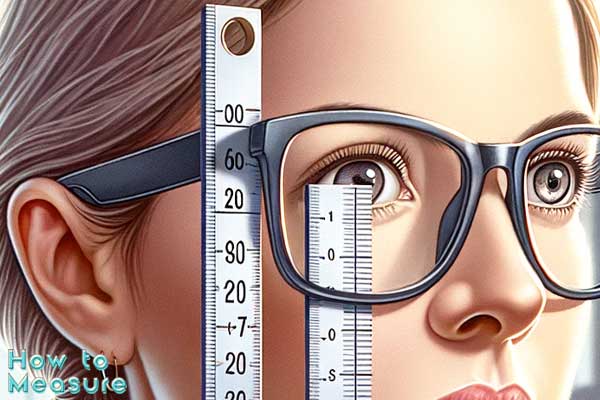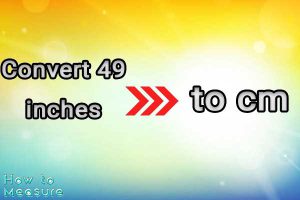Welcome to our in-depth article on how to measure ocular center (OC) height. This guide is essential for anyone who wears glasses, especially those with multifocal lenses like varifocals or bifocals. We’ll explore what OC height is, why it’s important, and provide a step-by-step process for accurately measuring it. Plus, we offer valuable information on measuring transom height on our website, How to Measure.
Understanding OC Measurement
Ocular Center (OC) measurement is a critical process in optometry that focuses on assessing the vertical alignment of the pupils in relation to the lenses of your glasses. This precise measurement is taken from the central point of each pupil down to the lower edge of the lens, as it sits within the frame of the glasses. This step is paramount in the customization of prescription eyewear, as it ensures that the lenses are perfectly aligned with the wearer’s line of sight.
Proper OC measurement is vital for achieving optimal vision through prescription glasses. It plays a significant role in the effectiveness of the lenses, particularly in multifocal eyewear such as bifocals or varifocals, where precision in lens placement directly impacts visual clarity and comfort. The OC measurement ensures that the focal points of the lenses correspond accurately to the wearer’s pupils, thereby enhancing the overall visual experience and reducing strain or discomfort. By meticulously determining this vertical placement, opticians can tailor glasses that not only correct vision but also offer a comfortable and natural viewing experience.
The Significance of OC Height in Varifocals and Other Multifocal Lenses
In the realm of eyewear, particularly with multifocal lenses like varifocals, the precise positioning of the wearer’s pupils is of paramount importance. Each lens in these types of glasses is designed with an apex, or an optical center, that ideally needs to coincide with the position of the wearer’s pupil. This crucial alignment, commonly referred to as ‘centration’, is attained through a meticulous combination of both horizontal and vertical measurements – the pupillary distances (PD) and the ocular center (OC) heights, respectively.
Centration is more than just a technical term in optometry; it’s the cornerstone for ensuring optimal functionality of the glasses. For varifocal lenses, which blend multiple optical powers within a single lens without visible lines, achieving perfect centration is especially critical. The process involves carefully measuring the distance between the pupils (PD) to align the lenses horizontally, and measuring the OC height to align them vertically. This dual-axis alignment ensures that the wearer’s line of sight passes directly through the optical centers of the lenses.
The benefits of accurate centration extend beyond mere visual clarity. When a wearer’s gaze precisely aligns with the center of the lenses, it ensures that the eyes are looking through the correct part of the lens for each visual task, whether it be reading, using a computer, or gazing into the distance. This not only maximizes the effectiveness of the varifocal lenses in providing clear and uninterrupted vision across different distances but also significantly reduces the risk of eye strain and visual discomfort. Moreover, proper centration can prevent posture-related issues. Without it, wearers might find themselves needing to adjust their head and neck position to see clearly, leading to physical discomfort over time. Thus, accurate centration, achieved through precise PD and OC measurements, is integral to the overall comfort, functionality, and effectiveness of varifocal glasses.
Step-by-Step Guide to Measuring OC Heights
To measure your OC (Optical Center) height, follow these detailed steps. This measurement is essential for ensuring that the lenses in your glasses are correctly aligned with your eyes, providing optimal vision and comfort. Here’s an expanded guide:
1. Prepare Your Materials:
- Glasses: Choose the glasses you intend to wear.
- Mirror: Use a mirror large enough to see your entire face.
- Ruler: A plastic or non-bendable ruler with clear markings, preferably in millimeters for more accurate measurement.
2. Position Yourself:
- Mirror Setup: Stand or sit in front of the mirror in a well-lit room. Ensure that your face is clearly visible without any shadows.
- Glasses Positioning: Wear your glasses as you normally would. Ensure they are properly adjusted and sit comfortably on your nose.
3. Align the Ruler:
- Ruler Orientation: Hold the ruler vertically in front of one lens. It’s crucial that the ruler is straight and not tilted.
- Zero Mark Alignment: Align the zero mark (beginning of the ruler) with the center of your pupil. The pupil is the black circle in the middle of your eye. This step might be easier if you close the other eye.
4. Measure the OC Height:
- Pupil to Lens Distance: While looking straight ahead, measure the distance from the center of your pupil to the bottom edge of the lens frame. This is your OC height.
- Ensure Accuracy: Repeat the measurement a few times to ensure accuracy.
5. Measure Both Eyes:
- Individual Eye Measurement: It’s important to measure both eyes separately as the OC height can vary between eyes.
- Repeat Steps for Other Eye: Using the same method, measure the OC height for the other eye.
6. Record Your Measurements:
- Note Down Measurements: Write down the measurements for each eye. If there is a significant difference between the two, this should be communicated when ordering lenses.
Pro Tips for Accurate Measurement
- Focus on measuring the lens, not the frame.
- Use a plastic ruler to prevent scratching your lenses.
- If necessary, close one eye to improve focus.
- For sunglasses, use a torch or light to illuminate your pupil from behind the lens for accurate measurement.
- Steady Gaze: Keep your head straight and look forward during the measurement.
- Assistance: If possible, have someone else read the measurement for you, as it can be tricky to do accurately on your own.
- Use Millimeters: Measurements are more precise in millimeters, so it’s recommended to use this unit.
Measuring PD for Progressive Lenses
Accurate PD measurements are crucial for progressive lenses. A dual pupillary distance measurement, the distance from each pupil’s center to the nose center, can be accurately done using a pupilometer.
OC in the Context of Glasses Prescription
The concept of Ocular Center (OC) is fundamental in understanding the intricacies of vision and eyewear optimization. Essentially, the OC denotes the precise positioning of your pupils within your eye structure, a factor that plays a crucial role in the accuracy and quality of your vision. This positioning is not just a static measurement; it reflects the dynamic relationship between your eyes and the world around you, influencing how effectively you can see and process visual information.
In the realm of optical science, the natural optical center of your eyes is regarded as the point that provides the most comprehensive and unobstructed visual perception. This center is the ideal focal point where light rays converge, allowing for the clearest and most accurate image formation on the retina. When your pupils are aligned with this natural optical center, your eyes can utilize their full potential in capturing and interpreting visual stimuli.
The alignment of the OC is particularly significant when considering corrective lenses. For eyeglasses or contact lenses to be effective, they must be designed and positioned in a way that complements the unique OC of each individual. This alignment ensures that the lenses correctly modify the incoming light to compensate for any refractive errors, such as nearsightedness or farsightedness, thereby enhancing the overall visual acuity.
Moreover, the concept of OC extends beyond mere physical alignment; it is integral to the holistic experience of vision. When your pupils are correctly aligned with the natural optical center, it facilitates a more relaxed and natural viewing experience, reducing eye strain and fatigue. This is especially crucial in activities that demand prolonged focus, such as reading, computer work, or driving.
In summary, the Ocular Center is a key element in visual health and optical correction, representing the optimal pupil positioning for accurate and comfortable vision. Understanding and aligning with your OC is essential in achieving the best possible visual experience, whether it be through natural sight or corrective lenses.
DIY OC Height Measurement
To measure your OC height at home, you need a marker, glasses, and an assistant. Mark a horizontal line on each lens at your pupil’s position while looking straight ahead. This method is particularly helpful for lenses with special coatings, as it preserves the measurement during transit to the optician.
Multifocal Lenses: An Overview
Multifocal lenses, including bifocals and varifocals, are designed for presbyopia, allowing clear vision at various distances. Varifocals offer a seamless transition between distances without visible lines, unlike bifocals.
Measuring OC Height from Home
- If using Home Try-On, wear your chosen frames and take a straight-on photo with your pupils centrally positioned.
- Measure your PD using the provided ruler.
- Send us the photos for precise measurement against your frame dimensions.
Conclusion
The process of measuring Ocular Center (OC) height is a critical component in the customization of eyewear, ensuring that your glasses not only offer the clearest vision but also the highest level of comfort. This precise measurement is fundamental in aligning the lenses of your glasses with your eyes’ natural line of sight. When the OC height is accurately gauged and applied, it guarantees that the optical centers of the lenses correspond perfectly with your pupils, thus optimizing visual clarity and reducing the likelihood of common issues such as eye strain and visual fatigue.
Eye strain, a common complaint among eyeglass wearers, often arises when the lenses are not properly aligned with the eyes. This misalignment forces the eyes to work harder to focus, leading to discomfort and fatigue. Similarly, incorrect OC measurements can lead to poor posture. Individuals may find themselves adjusting their head and neck position to see more clearly through their lenses, potentially causing neck and back discomfort over time.
Therefore, the importance of precise OC height measurement extends beyond basic vision correction; it plays a significant role in the overall well-being of the wearer. Properly fitted glasses with accurately measured OC height contribute to a more natural and comfortable viewing experience, allowing for prolonged use without discomfort.
For those seeking to ensure their eyewear is perfectly tailored to their needs, professional guidance is invaluable. Visiting “How to Measure” offers access to expert advice and detailed instructions on how to accurately measure OC height, ensuring that your glasses are a perfect fit for both your vision and comfort requirements. With the right tools and expertise, you can enjoy the benefits of eyewear that not only corrects your vision but also supports your overall eye health and physical well-being.













